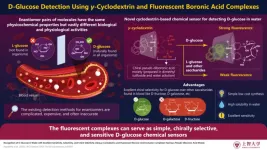(Press-News.org) In the 35 years before the covid-19 pandemic, the US government invested at least $337 million into critical research that led to the mRNA covid-19 vaccines, finds a study published by The BMJ today.
The US government also paid $31.6 billion during the pandemic to support vaccine research, production, and to purchase vaccines for all Americans and for global donation.
These public investments saved millions of lives - and mRNA vaccine technology also has the potential to address future pandemics and treat other diseases. But the researchers point out that products developed with public funding, including mRNA covid-19 vaccines, are often sold at high prices.
As such, they assert that to maximize overall health impact and fairness, greater effort is needed to ensure equitable and affordable access to publicly funded health technologies.
Estimates of the extent of public investment for covid-19 vaccines vary widely. So, a team of US researchers at the Program on Regulation, Therapeutics, and Law (PORTAL) at Brigham and Women’s Hospital and Harvard Medical School, set out to assess how much the US government invested in research that directly led to the development of mRNA covid-19 vaccines.
They identified public funding from January 1985 to March 2022 through three primary data sources – the National Institutes of Health (NIH) Research Portfolio Online Reporting Tool Expenditures and Results (RePORTER), the Department of Defense (DoD) Contracts database, and the Biomedical Advanced Research and Development Authority (BARDA) Medical Countermeasures Portfolio.
NIH-funded grants were scored as directly, indirectly, or not likely related to four key innovations underlying mRNA covid-19 vaccines - lipid nanoparticle, mRNA synthesis or modification, prefusion spike protein structure, and mRNA vaccine biotechnology - and were grouped into pre-pandemic (1985-2019) vs pandemic (2020 - March 31, 2022).
The researchers identified 34 NIH-funded research grants that were directly related to mRNA covid-19 vaccines. These grants combined with other identified US government grants and contracts totaled $31.9 billion, of which $337 million was invested pre-pandemic.
Pre-pandemic, the NIH invested $116 million (35%) in basic and translational science while BARDA invested $148 million (44%) and the DoD invested $72 million (21%) into mRNA vaccine development and clinical trials.
After the pandemic started, $29.2 billion (92%) of US public funds purchased vaccines, $2.2 billion (7%) supported clinical trials, and $108 million (less than 1%) invested in manufacturing plus basic and translational science.
This is the first study to systematically catalog the direct pre-pandemic US public investments in mRNA covid-19 vaccines and provides a robust, yet conservative estimate, say the researchers.
But they acknowledge that this study does not include the financial support from other countries, foundations, or companies and is therefore likely a substantial underestimate of the total pre-pandemic investment of public funds.
They suggest policy reforms to improve equitable access to publicly-funded inventions like mRNA covid-19 vaccines could include adding access, affordability, and equity conditions to government contracts, and encouraging public funding agencies to follow up on technology licenses to ensure that manufacturers are making the products appropriately available for the benefit of public health.
The development of mRNA covid-19 vaccines during the pandemic was a monumental scientific success, they write. The substantial role played by public funding should help justify greater efforts by governments to assure equitable and affordable access to this life-saving vaccine in the US and globally.
In a linked editorial, Victor Roy at Yale School of Medicine agrees that the mRNA covid-19 vaccines have been a remarkable achievement.
However, he says their development “also serves as a cautionary tale of a system in which the risks of pursuing innovation were socialized, while the lion’s share of rewards became privatized to corporate shareholders.”
He points out that, since their launch, Moderna and Pfizer have accumulated more than $100bn in global revenues from sales of covid-19 vaccines—more than 20 times the World Health Organization’s biennial budget in 2020-21.
He therefore suggests an alternate innovation strategy that includes directionality, conditionality, and public options.
“Instead of maximizing value for corporate shareholders, these alternatives would enable governments to translate public investments more fully in the service of public health—a fundamental priority as we examine our response to this pandemic and prepare for the next,” he concludes.
END
US government catalyzed and substantially invested in mRNA covid-19 vaccine development over decades
2023-03-02
ELSE PRESS RELEASES FROM THIS DATE:
Public investment in critical research contributed to the success of mRNA COVID-19 vaccines
2023-03-02
Moderna and Pfizer-BioNTech have recently announced plans to increase the price of their respective mRNA COVID-19 vaccines, thrusting them into the spotlight of debates around drug price hikes. A new study, led by investigators from Brigham and Women’s Hospital, a founding member of the Mass General Brigham health care system, analyzed the role of public funding in the development of mRNA vaccines. In a systematic assessment, the team found that over the last 35 years, three federal agencies—the National Institutes of Health, the Department ...
Only two in five British businesses have introduced support to help staff with the rising cost of living as many see operating costs rise
2023-03-02
New research from the Work Foundation at Lancaster University reveals that while two thirds of senior business leaders (66%) agree that employers have a ‘substantial role’ to play in supporting staff through the rising cost of living, only 40% have introduced new support measures since the start of 2022.
At the same time, four in ten business leaders (41%) also report increases in production costs in their organisation. Pressures that are likely to increase, the Work Foundation ...
Fishing for proteins: Scientists use new optical tweezer technology to study DNA repair
2023-03-02
Tucked away in a small, dark room at UPMC Hillman Cancer Center, Brittani Schnable is on a fishing expedition.
Wielding a joystick similar to those used by video gamers, she casts microscopic beads into an ocean of molecules, pushing and pulling the beads apart until they eventually catch a strand of DNA. After a few taps of the keyboard, a lightshow begins. A burst of colors flashes across the black screen like fireworks exploding in the night sky.
Although these colors seem random at first, a pattern starts to emerge. Lines of blue and red light streak across the screen: A DNA repair protein has bound to the site of damage.
Schnable, a Ph.D. student in Dr. Bennett ...
Can’t exercise a particular muscle? Strengthening the opposite side of your body can stop it wasting away
2023-03-02
Loss of muscle strength can be one of the most damaging outcomes when someone is unable to move a part of their body for a long period of time.
But a new Edith Cowan University (ECU) study may have found a way to offset or even protect against this — and it doesn’t even involve the affected body part at all.
Injury or illness may see a part of the body incapacitated for weeks or even months, causing unused muscles to weaken and lose their mass and strength, which can have ...
Physical activity can help mental health in pre-teen years
2023-03-02
Regular physical activity can improve adolescents’ mental health and help with behavioural difficulties, research suggests.
Engaging in regular moderate to vigorous physical activity at age 11 was associated with better mental health between the ages of 11 and 13, the study found.
Physical activity was also associated with reduced hyperactivity and behavioural problems, such as loss of temper, fighting with other children, lying, and stealing, in young people.
Researchers from the Universities of Edinburgh, Strathclyde, Bristol, and Georgia in the United States explored data from the Children of the 90s study (also known as the Avon Longitudinal Study of ...
New fluorescent chiral-selective receptor system represents a breakthrough in molecular detection with potential for applications in diabetes management
2023-03-02
Diabetes mellitus, simply called diabetes, is a metabolic disorder characterized by the presence of abnormally high concentrations of glucose in blood. Existing methods for the diagnosis of diabetes rely on traditional techniques of detecting glucose in blood serum samples—a process that is typically tedious and expensive.
Molecular recognition is the science of accurately detecting specific compounds by exploiting their binding properties. Here, a receptor molecule–a kind of sensor–selectively binds to a target molecule. This process triggers some reaction, say, a change ...
Sleep too much or too little and you might get sick more, scientists find
2023-03-02
A good night’s sleep can solve all sorts of problems – but scientists have now discovered new evidence that sleeping well may make you less vulnerable to infection. Scientists at the University of Bergen recruited medical students working in doctors’ surgeries to hand out short questionnaires to patients, asking about sleep quality and recent infections. They found that patients who reported sleeping too little or too much were more likely also to report a recent infection, and patients ...
Study suggests EHR-focused interventions can significantly reduce unnecessary urine cultures among hospital patients
2023-03-02
Study Suggests EHR-Focused Interventions Can Significantly Reduce Unnecessary Urine Cultures Among Hospital Patients
Initiative highlighted in AJIC provides model for resource-limited institutions to decrease overdiagnosis and overtreatment of asymptomatic bacterial infections
Arlington, Va., March 2, 2023 – Physicians in the largest safety-net hospital system in the United States used two electronic health record (EHR)-focused interventions to significantly reduce inappropriate urine cultures among hospitalized patients. Findings from their study, published in the ...
Edible electronics: How a seaweed second skin could transform health and fitness sensor tech
2023-03-02
Scientists at the University of Sussex have successfully trialed new biodegradable health sensors that could change the way we experience personal healthcare and fitness monitoring technology.
The team at Sussex have developed the new health sensors – such as those worn by runners or patients to monitor heart rate and temperature – using natural elements like rock salt, water and seaweed, combined with graphene. Because they are solely made with ingredients found in nature, the sensors are fully biodegradable, making them more environmentally friendly than commonly used rubber and plastic-based alternatives. Their natural ...
Cocaethylene cardiotoxicity in emergency department patients with acute drug overdose
2023-03-01
Des Plaines, IL — When compared to cocaine exposure alone, cocaine and ethanol exposure in emergency department (ED) patients with acute drug overdose was significantly associated with higher occurrence of cardiac arrest, higher mean lactate concentrations, and lower occurrence of myocardial injury. This is the conclusion of a study titled, Cocaethylene cardiotoxicity in emergency department patients with acute drug overdose published in the February issue of Academic Emergency Medicine (AEM), the peer-reviewed journal of the Society for Academic Emergency ...


